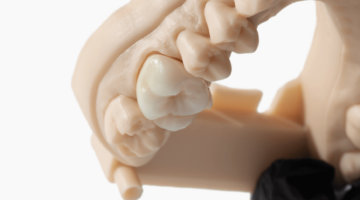As a dentist, your mission is to provide patients with high-quality oral care and the best patient experience. Both factors play a pivotal role in overall patient satisfaction and outcomes and, thus, the success of your clinic.
But how can you ensure that your patients are satisfied with your care delivery?
In this post, we’ll look at three creative ways to increase patient satisfaction.
Patient experience vs patient satisfaction
To begin, let’s categorize and define some terms. Patient satisfaction and patient experience are often used interchangeably, yet depending on how they’re measured (and what they measure), they’re not synonymous.
While there’s no single standardized definition, they do tend toward unique, distinguishing features:
- Patient experience (PE) – PE conveys a sentiment that goes beyond the singular trip to the dental clinic for a cleanup. It refers to the totality of the experience from the initial touchpoint on. This could cover interactions with the team, the location and physical environment itself, the brand perceptions, and the care processes. Learning how to improve the patient experience will only be helpful to you and your practice.
- Patient satisfaction (PS) – PS is more focused on how patient expectations—formed via previous experiences, narratives, and social cues—align with the end results of the actual care delivery. It measures the quality of care, communication, and overall experience. When reality falls in line with or exceeds expectations, the patient is satisfied with their care.
Today’s healthcare patient-consumers view dental care as a high-cost commodity. As a result, they want to be treated like the high-paying consumers they are.
As Dental Economics notes, most patients already assume that clinical outcomes will be positive. Therefore, dental teams should “be committed to providing five-star customer service and building long-term, trust-based relationships, not only to facilitate case acceptance but also to ensure positive online reviews.”
With this in mind, let’s explore three concrete tips to improve patient satisfaction.
Tip #1: Improve interpersonal communication
Interpersonal communication is essential in patient decision-making.
Even if you’re a skilled and knowledgeable dental specialist, your practice may struggle if you lack soft skills, both verbal and non-verbal. You need to be able to communicate clearly and with compassion, listen empathetically, and connect with patients on a personal level.
Patient communication forms the essential bridge of trust that links the patient to their healthcare provider. When patients feel heard, understood, and respected, they’re more likely to be satisfied with their care provider. Communication also helps ensure that patients are fully informed of their treatment options, understand their diagnosis and treatment, and have the confidence to ask relevant questions.
According to Medical Economics:
“A clear relationship exists between a healthcare provider’s ability to communicate and patient outcomes. Patients who feel connected to their provider are more likely to follow the treatment plan, follow up with their doctor, and take their prescribed medication. This goes a long way toward ensuring better health outcomes for patients.”
To facilitate this, dental professionals should:
- Schedule follow-up calls to check in on the patient
- Use digital tools and technologies that facilitate patient education and communication
- Invite patient feedback and reviews
- Ask questions and listen attentively
- Provide visual aids, so patients better understand the dental procedure
- Thoroughly explain costs and options so they can make informed decisions
Aside from interpersonal communication, communicating and discovering potential clients is just as important, which is where brainstorming for dental marketing ideas comes in. You can also improve patient satisfaction by being responsive to patient feedback. If you listen to their concerns before, during, and after their treatment, they likely leave satisfied patients.
Tip #2: Minimize wait and chair times
From both a patient satisfaction vantage point and an economics lens, less average chair time per patient results in better outcomes. Dental clinics can treat more patients, and those patients can get in and out without feeling as though their time is wasted. Long wait and chair times can also alter patient perception and even lead to patient dissatisfaction.
But how do you minimize wait times, reach dental KPIs, and maintain patient retention?
Try these patient retention strategies:
- Utilize dental auxiliaries – You likely already implement this in your medical practice in some capacity, but wherever possible, delegate lower-level tasks to dental assistants and dental hygienists. This frees up the dentist to see more patients simultaneously while focusing on value-add services.
- Assign a scheduling coordinator – An appointment that starts on time does a lot to boost the patient experience, and satisfied patients are, of course, your goal. At least one of your front office workers should be charged with developing a schedule that maximizes productivity and efficiency while minimizing patient wait time and dentist idle time.
- Optimize outmoded procedures – The fewer appointments a patient must undergo and the shorter those appointments are, the happier the patient will be. Fortunately, there are new technologies, such as Dandy’s digital denture workflows that transform what used to be an 8-appointment procedure into a 2-appointment solution.
Tip #3: Embrace digital dental technologies
Technology can help streamline dental practice management, patient care, and to a certain extent patient safety. Your practice might even generate a higher patient satisfaction score if your patient care properly integrates new dental technology. An overwhelming percentage of patients support using new technological advancements in dentistry in their dental care. While speed is certainly a factor, comfort during procedures can also impact satisfaction rates.
For instance, consider the conventional analog impression-taking process.
Traditionally, dentists would use a mold impression to visualize the patient’s teeth and mouth. Often these molds would then be used for restorations like crowns, bridges, implants, and aligners.
But this process was inherently flawed for both patients and dental clinics. It tended to be error-prone, time-consuming, expensive, and uncomfortable, especially for patients with a strong gag reflex. And the physical mold would have to be shipped back and forth between the clinic and the dental lab.
Dandy’s digital dental impression process has completely modernized this low-satisfaction process. With the aid of an intraoral scanner, a dentist can rapidly capture a flawless digital dental impression, automatically recording the size and shape of each tooth to render a 3D file of the patient’s mouth.
By embracing modern dental technologies, clinics can replace the unpopular conventional process with a quick, pain-free, no-gag alternative.
Dandy—driving patient satisfaction
To thrive in today’s competitive climate, dental clinics must take proactive steps to foster patient satisfaction. By improving communication, minimizing chair time, and embracing digital technology, you can ensure that your patients leave your clinic happy with a brighter, healthier smile.
With Dandy’s digital workflows, you can achieve all of these objectives in a single stroke. From the intraoral scan to the 3D rendering, our technologies help ensure that patients enjoy a better experience and improved outcomes.
Want to see how we can level up your medical practice?
Reach out to learn more today.
Sources:
Dental Economics. The patient experience matters most. https://www.dentaleconomics.com/practice/article/14068347/the-patient-experience-matters-most
Medical Economics. Transforming the patient experience: Tips for better patient communication. https://www.medicaleconomics.com/view/transforming-patient-experience-tips-better-patient-communication
Business Wire. New Research from Pearl Offers Insight into Dental Patient Trust and Perceptions of Technology. https://www.businesswire.com/news/home/20221004005032/en/New-Research-from-Pearl-Offers-Insight-into-Dental-Patient-Trust-and-Perceptions-of-Technology



